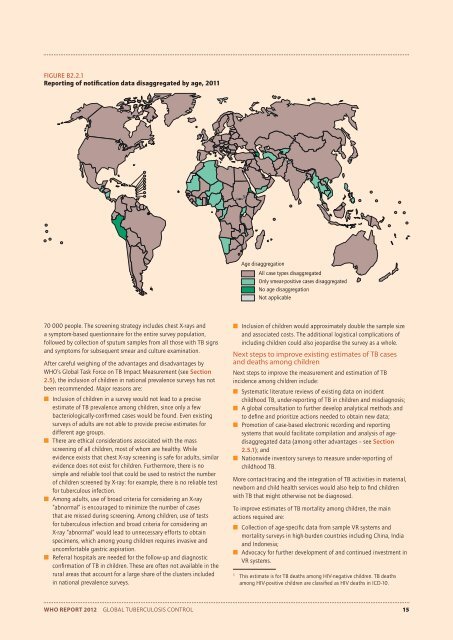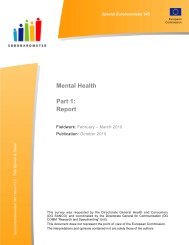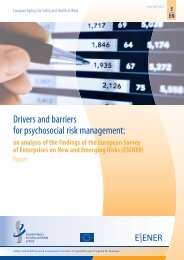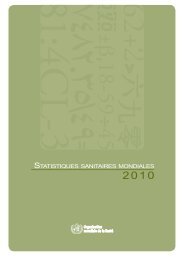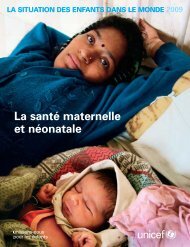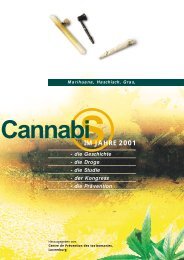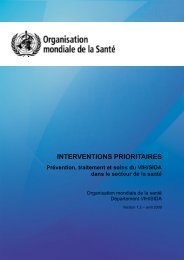Global Tuberculosis Report -- 2012.pdf
Global Tuberculosis Report -- 2012.pdf
Global Tuberculosis Report -- 2012.pdf
Create successful ePaper yourself
Turn your PDF publications into a flip-book with our unique Google optimized e-Paper software.
FIGURE B2.2.1<br />
<strong>Report</strong>ing of notification data disaggregated by age, 2011<br />
Age disaggregation<br />
All case types disaggregated<br />
Only smear-positive cases disaggregated<br />
No age disaggregation<br />
Not applicable<br />
70 000 people. The screening strategy includes chest X-rays and<br />
a symptom-based questionnaire for the entire survey population,<br />
followed by collection of sputum samples from all those with TB signs<br />
and symptoms for subsequent smear and culture examination.<br />
After careful weighing of the advantages and disadvantages by<br />
WHO’s <strong>Global</strong> Task Force on TB Impact Measurement (see Section<br />
2.5), the inclusion of children in national prevalence surveys has not<br />
been recommended. Major reasons are:<br />
■ Inclusion of children in a survey would not lead to a precise<br />
estimate of TB prevalence among children, since only a few<br />
bacteriologically-confi rmed cases would be found. Even existing<br />
surveys of adults are not able to provide precise estimates for<br />
different age groups.<br />
■ There are ethical considerations associated with the mass<br />
screening of all children, most of whom are healthy. While<br />
evidence exists that chest X-ray screening is safe for adults, similar<br />
evidence does not exist for children. Furthermore, there is no<br />
simple and reliable tool that could be used to restrict the number<br />
of children screened by X-ray: for example, there is no reliable test<br />
for tuberculous infection.<br />
■ Among adults, use of broad criteria for considering an X-ray<br />
“abnormal” is encouraged to minimize the number of cases<br />
that are missed during screening. Among children, use of tests<br />
for tuberculous infection and broad criteria for considering an<br />
X-ray “abnormal” would lead to unnecessary efforts to obtain<br />
specimens, which among young children requires invasive and<br />
uncomfortable gastric aspiration.<br />
■ Referral hospitals are needed for the follow-up and diagnostic<br />
confi rmation of TB in children. These are often not available in the<br />
rural areas that account for a large share of the clusters included<br />
in national prevalence surveys.<br />
■ Inclusion of children would approximately double the sample size<br />
and associated costs. The additional logistical complications of<br />
including children could also jeopardise the survey as a whole.<br />
Next steps to improve existing estimates of TB cases<br />
and deaths among children<br />
Next steps to improve the measurement and estimation of TB<br />
incidence among children include:<br />
■ Systematic literature reviews of existing data on incident<br />
childhood TB, under-reporting of TB in children and misdiagnosis;<br />
■ A global consultation to further develop analytical methods and<br />
to defi ne and prioritize actions needed to obtain new data;<br />
■ Promotion of case-based electronic recording and reporting<br />
systems that would facilitate compilation and analysis of agedisaggregated<br />
data (among other advantages – see Section<br />
2.5.1); and<br />
■ Nationwide inventory surveys to measure under-reporting of<br />
childhood TB.<br />
More contact-tracing and the integration of TB activities in maternal,<br />
newborn and child health services would also help to fi nd children<br />
with TB that might otherwise not be diagnosed.<br />
To improve estimates of TB mortality among children, the main<br />
actions required are:<br />
■ Collection of age-specifi c data from sample VR systems and<br />
mortality surveys in high-burden countries including China, India<br />
and Indonesia;<br />
■ Advocacy for further development of and continued investment in<br />
VR systems.<br />
1<br />
This estimate is for TB deaths among HIV-negative children. TB deaths<br />
among HIV-positive children are classifi ed as HIV deaths in ICD-10.<br />
WHO REPORT 2012 GLOBAL TUBERCULOSIS CONTROL 15


